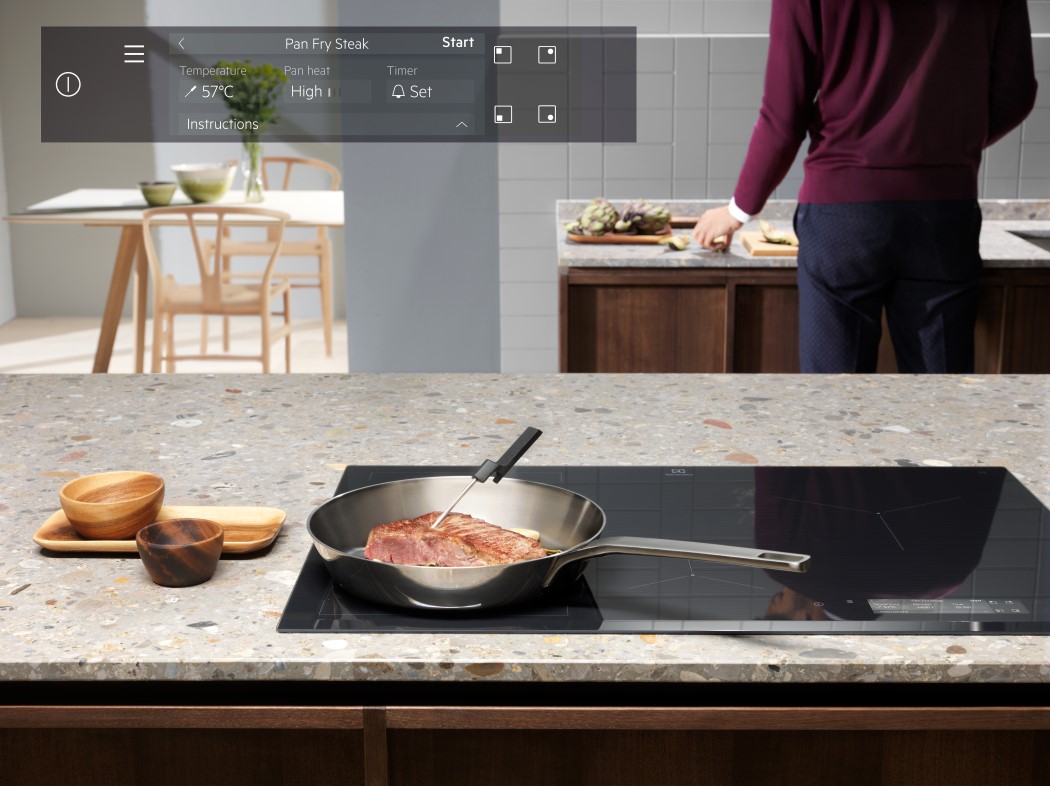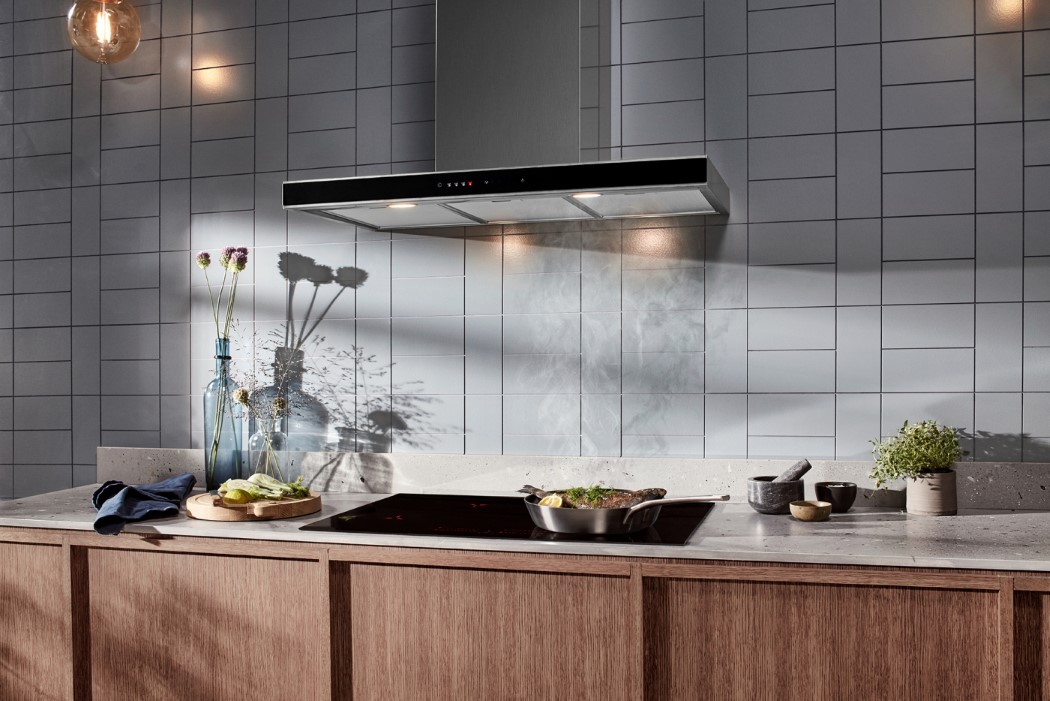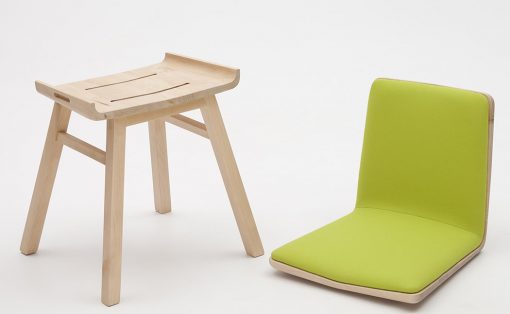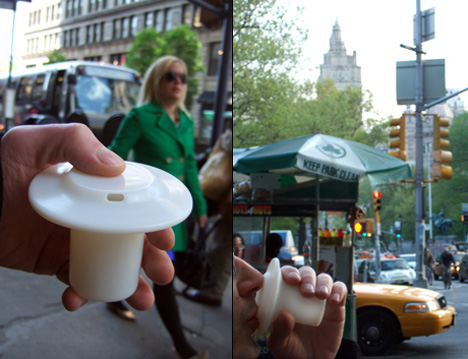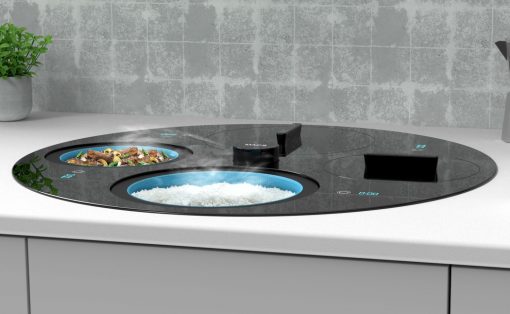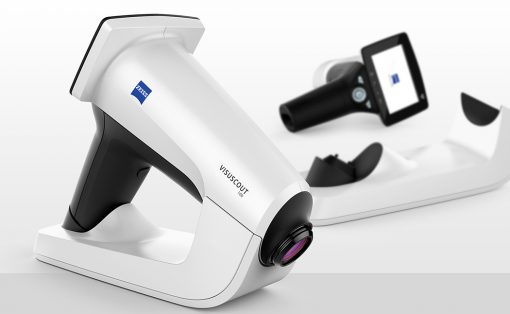![]()
Simon Bradford is sitting in the conference room waiting for us. He’s just demoed Electrolux‘s Intuit kitchen range, a cutting-edge range of kitchen appliances that are more than just instruments, they are enablers. I’m talking ovens with closed-circuit cameras in them and induction hobs that can tell the chimney when to switch on or off. Bradford’s spent years developing the products around this technology, creating kitchen tools that can turn amateurs into experts, and can help experts cook things they couldn’t before. After the demo, Simon even took us through the design process he’s instated at Electrolux, putting the consumer experience at the absolute forefront. We enter the conference room and are greeted by a warm welcome, after which we speak to Simon about a lot of things, ranging from his view on design in the past and the present, his thoughts on Silicon Valley’s motto of moving fast and breaking things, and we even asked him about the new Mac Pro 2019 (how could we not!) Simon explained to us how he approached designing his range, what the next big thing was for Electrolux after introducing Artificial Intelligence and intuition to cooking, and the distinction between designing using the the glorious past as a reference, and the exciting future as a direction.
Yanko Design: Hey Simon! Loved the presentation and especially the Intuit Range. For the people reading this interview, we literally made the most perfect pancakes on the SensePro induction cooker, and the cooker literally told us when it was time to pour the batter. The pancakes were absolutely perfect! So now that our stomachs are full, let’s head into this interview! Hi Simon, tell us a little about you and your role in Electrolux today.
Simon Bradford: Hey! Lovely having you here! I’ve been with the Electrolux group for almost 10 years. Started my journey with Philips, then moved onto Sony, then Nokia, and finally Electrolux here in Stockholm, Sweden. I’ve honestly liked working with corporate design organizations, because you really work within the full spectrum. You go from consumer insights to visiting peoples’ homes, all the way to the product rolling off the production line to launches like the this one! So, I started here as Head of design for Floor Care & Small Appliances. Five years ago I started on the major appliance journey as head designer there.
The kitchen space is a very emotional category to be involved in and it is continuously changing. It’s all about great tasting food! People buy appliances because they like cooking great tasting meals for family and friends, loved ones, on the weekend and during the week. With the arrival of connectivity, it’s an extremely interesting product category to be involved in because it is going to completely change it; change people’s behaviors, change the way we interact with our products, and change the way we consume food. This is what is driving me in my role and has done for the past 10 years.
![]()
YD: How did the range come about? What was the starting point?
SB:The clue is in the word “Intuit”. It is short for Intuitive, meaning something which is totally seamless and easy to understand. In our daily lives we are surrounded by negative stereotypes or user pain points. By putting the consumer at the heart of everything we do, is when we can start turning those negatives into meaningful experiences. Our definition of an outstanding experiences can be summarized by the following three words: Effortless, Enriching and Empowering. By Effortless we mean making things easy, taking away all friction points. Enriching means making the experience memorable, by creating moment of magic and tapping into all the human senses, touch, smell, hearing… And finally Empowering, meaning we adapt to the consumer, offering them solutions to expand their cooking repertoire!
YD: If we’re talking about enriching, I’d just love to go back to one of my favorite design details of the entire range. That swiveling refrigerator tray! As an industrial designer turned writer, that absolutely blew my mind. The intricate design, the way it comes slightly forwards so the tray can rotate a full 360°, it was just a treat to look at! How do you approach such a design problem? I’m assuming you went through multiple iterations.
SB: Hahah! I like the question, and I think I tried to convey that in my presentation earlier. We’re honestly learning a lot from Silicon Valley, we’re learning a lot from companies in the digital world who work agile. It’s very much this test, learn, iterate type of process, but you do it very quickly, until you’re really sure that the proposition you’re bringing into the market is the right one. The SpinView (rotating tray) was a great example of how we iterated time and time again, loads of cardboard mockups, but we’ve definitely been on this journey of being agile. Normally, a few years ago, the old fashioned way would be to build it, hard-tool it, bring it to market, and consumers tell you “Hey, it’s rubbish”. Our focus now on Consumer Experience helps us really pick up on feedback and gain insights on what they think, and we’ve spent a considerable amount of effort and money on developing tools that help us very quickly capture consumer feedback from reviews all over the internet, helping us be as agile as our American counterparts.
As far as the SpinView is concerned, the insight came from observing consumer behaviors rather than just feedback analysis. Do you know that 30% of the food in the fridge gets thrown out. Why? Purely due to lack of visibility. We see a lot of fresh fruit, vegetables, basically rotting away at the back purely due to lack of visibility. Among other features, SpinView was designed to uplift the refrigeration experience, while also ensuring that food doesn’t go to waste!
YD: You often mention the importance of human-centric design and the consumer experience. What does that mean to you?
SB: To me it means following a creative process that is centered around the user. Only when we have truly understood the needs of our consumer, can we then design experiences that will improve their daily lives.
YD: Okay, here’s a difficult question though. How much do you think Design Thinking has the potential to influence the workings of a corporate like Electrolux? At the end of the day a company is answerable to a board, its investors, and a wide variety of people, so is it easy to highlight the importance of design over reports and statistics?
SB: Design is a negotiation. It’s a collaborative process between all entities. Not every company is like Apple! There have been multiple instances where a design has been too expensive, or hasn’t effectively fulfilled a consumer need, which I think is an absolute failure. And in a corporate environment, there’s obviously a commercial reality that everyone has to face. A product needs to fulfill all expectations, and not necessarily those of just the consumer, right?
YD: That commercial reality is perhaps what is missing from design institutions, don’t you think? Is there anything you had to unlearn while entering the industry?
SB: What I really had to unlearn is that design isn’t all about cosmetics. When I graduated many years ago, the norm was to plaster the wall with as many sketches as possible, it was a bit of a beauty contest. Design is so much more than that. It’s about experience, which I’ve talked about. It’s about appeal, but it’s also about usability, low effort, robustness, longevity, and fulfilling a consumer need. The appeal is almost a by-product. If you get the insight right, and you’re solving a pain-point, the appeal will come naturally.
YD: Although this reality you mentioned is somewhat in contrast with what the Electrolux Design Lab has been about, right? Design Lab was always about creating outrageously futuristic concepts with focus on technologies that don’t exist and are purely conceptual.
SB: You’re right. With Design Lab, I’d claim that almost all the designs were based on insight, but it depends on how far-fetched the execution is. We often use the terms horizons. Is it a horizon 2,5,10 product? Naturally when you’re working for a company or you’re employed, you keep your horizon relatively close otherwise you disconnect yourself from the business. But with students, we want them to push the boundaries. They aren’t constrained yet, but it takes a couple of years of working in the industry for the horizon to emerge closer and closer, as designers start looking at commercial realities. It’s about finding the right balance while you’re in the industry, but with Design Lab it’s all about pushing boundaries.
![]()
(An Electrolux Design Lab winning concept for a refrigerator made for flat-sharing students with individual compartments).
YD: If we’re talking about pushing boundaries, let’s just go back to Silicon Valley for a second and look at their entire “move fast and break things” mantra. You see a company like Apple truly innovating, but when they do something like removing the headphone jack from their phones, how do you view their version of innovation versus Electrolux’s human-centric innovation? Do you think this fast-paced, often consumer-unfriendly innovation is healthy?
SB: I’ve worked for Nokia for 6 years, so I know all about Apple coming and disrupting businesses! Hahaha! I think they can afford it, because they’re the leaders and they’ve got a huge fan-base so probably they’ll be pardoned! But then, you see how their iPad now has a USB-C charger, which is the same charger for my laptop, and quite a few other devices, and there’s a synergy that Apple’s opting for. Nokia had their own issues too. There were too many chargers and too many different platforms, and it became a mess. Honestly though, I think it’s interesting that they removed the headset jack, because it kick-started a new industry in the truly wireless headphones. In the defense of human-centric design, maybe that innovation was forced upon the users.
YD: Your thoughts on the latest Mac Pro?
SB: I’ve just seen the images, haven’t seen one in the stores yet… but you’ll remember me talking about commercial realities. We’ll know how much of a success it is soon enough! Even though Apple doesn’t disclose the number of products they’ve sold anymore, I think we’ll get a rough idea whether that design worked or not!
YD: Back to Electrolux! What’s the stuff you’re working on now? I understand Electrolux also owns multiple sub-brands, AEG being one of the more notable ones. How does designing for Electrolux differ from designing for AEG? Is there a distinct difference in the way you approach designing for the two brands within the same company?
SB: The Intuit Range has to be the most recent thing we’ve worked on. You may have seen the AEG version of it last year, and we’ve been working to develop the range under both brands. Both brands have their own directions, heritages, provenances, and even users… so we approach designing products for both brands differently. For example AEG’s Germany-heavy audience focuses more on power-features, while Electrolux’s users definitely look for ease-of-use. It’s a fun challenge designing for both scenarios!
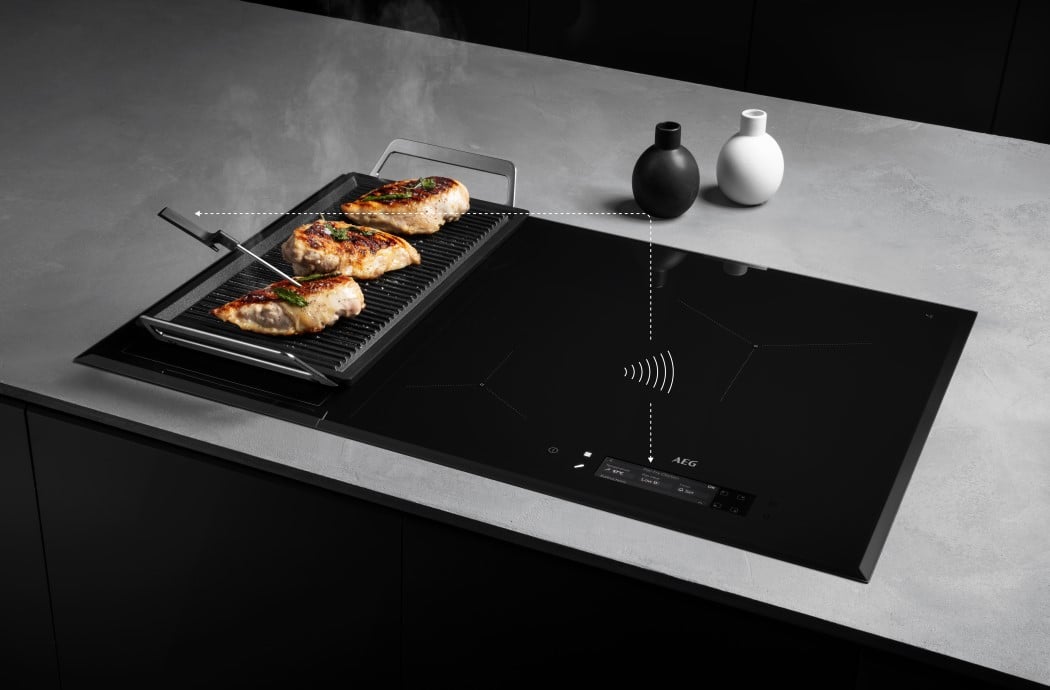
YD: There’s a lot of talk about sustainability. How does Electrolux view sustainability as a goal with its range of products?
SB: Oh, sustainability is definitely a strong theme. It isn’t just about designing a product, it’s also about helping people live sustainable lives, cook more sustainably, etc. The industry hasn’t changed much in the food-world for roughly 50-60 years, and the concept of ovens has pretty much been the same. Heat up a cavity and cook meats or pies inside it. So with connectivity, we’re also trying to build a sustainable world. Imagine a fridge that could know what’s inside it, and suggest recipes based on the items you own and beam those recipes to your oven. Electrolux is always actively working to build products that help people live better, healthier lives… not just for them, but also for the grander scheme of things.
YD: Wait, so did this push come from consumer insights? Or was it a design decision?
SB: Oh, it was a CEO decision! It came right from the top! It’s actually one of the company’s values, so it was natural that it would be a driver for our company. It affects everything we do. The way we design our products, how we run our factories, deal with suppliers, deliver goods, material choices, everything… and those are honestly the easier bits. The challenging thing is how to alter consumer behavior. A great example is our dishwasher, which does away with all features and has the most simple UI of a dishwasher, based entirely on one metric. Time. All the user does is select the time in which their dishes are washed, and the appliance does the rest. The longer time you select, the more water-efficient the machine is, and that’s much more eco-friendly… the UI was designed to promote that and educate the user that the longer cycles are more sustainable for the planet, while the shorter ones focus on cleaning efficiently and fast, often using more water in the process. Changing materials to more eco-friendly alternatives is really just the easier bit. We’re also trying to change user behaviors, which is the bigger play, and what’s better for the planet.
YD: This was an incredibly insightful conversation Simon! Thanks for taking the time out to speak with us, and for designing some truly innovative products! Any final remarks?
SB: It is a very fascinating time to be working at Electrolux! For many reasons: We are celebrating our 100 year anniversary, we are living in a ever changing digital world where the consumer experiences matter! And finally Electrolux is leveraging its Scandinavian heritage, its knowhow in Taste, Care, Wellbeing and its leadership in sustainability to continue bringing outstanding user experiences to our consumers for another 100 years!
[You can check out YD’s coverage on Electrolux and AEG’s products by vising this tag]
![]()
